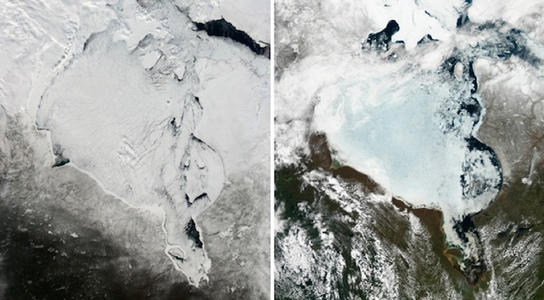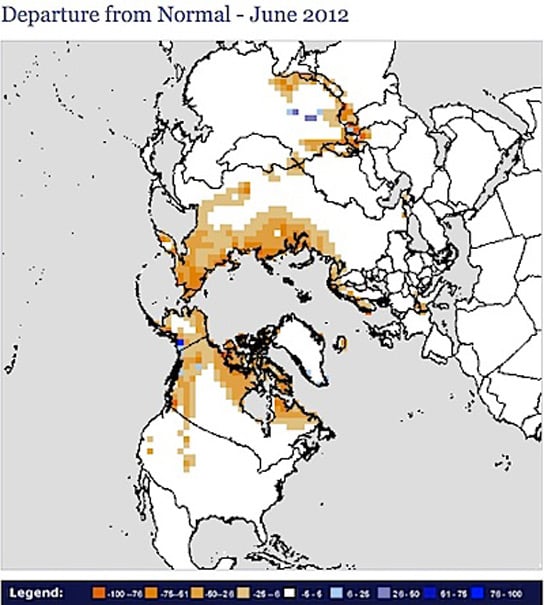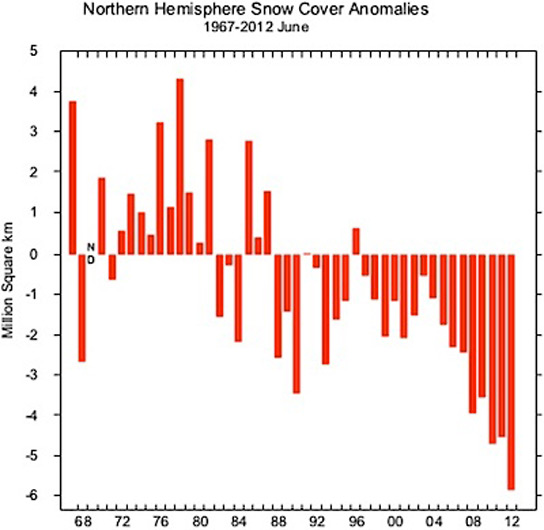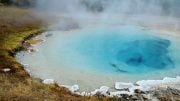
Hudson Bay on April 6 (left) and June 5 (right), 2012. Credit: NASA
While it may seem that melting arctic snow isn’t as dramatic as the record ice melt that’s occurred this year, the loss of arctic snow potentially has profound consequences for weather patterns, especially in the USA.
Across the Arctic, snow melted earlier and more completely than in recorded history. Similar to the way ice loss exposes dark water to the sun’s radiant heat, melting snow allows the exposed ground to heat up, adding to the Arctic’s warming. This extra heat retention is affecting the polar jet stream, effectively altering it and causing mid-latitude weather patterns to linger. It’s possible that this might also be prolonging the North American drought, which is the worst since the Dust Bowl in the 1930s that was fueled in part by climate change in the Arctic.

Variation from the post-1967 historical norm in June snow cover, June 2012. Dark orange corresponds to between 75 and 100 percent below average. Credit: Rutgers University Climate Lab
Artic conditions combined with or weather conditions, like El Niño, result in more extreme climate events. The Arctic sea ice has declined by 50% since the late 1970s, and this has been topped off by a record melt this year. In September the ice covered a smaller area than any other time in the climate record.
In June the Arctic snow cover also reached a historic low. While it didn’t receive that much attention, the snow has been retreating for several decades and it has declined just as precipitously as the sea ice, exposing ground to the sun.
Scientists are just now starting to understand the relationship between the Arctic snow and weather patterns across lower North America. Just like the sea, exposed ground will heat up and surface temperatures will rise. This heat returns into the atmosphere during the fall and winter, reducing the temperature gradient between the Arctic and lower latitudes. This difference is what propels the northern hemisphere’s polar jet stream, the globe-spanning atmospheric current that pushes vast amounts of cold air south and warm air north.

Northern hemisphere snow coverage, in millions of square kilometers, as compared to the post-1967 average. Credit: Rutgers University Climate Lab
Warm air takes up more space than cold air, so the atmosphere in the south is thicker. The Earth’s spin and the layering of the atmosphere turn the currents towards the right, and that’s what creates the jet stream. Once the Arctic is warmed up, the gradients are less steep, as such the jet streams will be displaced and slower.
For now, this is still a hypothesis, but recent years and similar observations in Siberia might just be the tipping point. A new paper in the journal Geophysical Research Letters, describes how atmospheric pressure patterns generated by extreme spring snow melts in the last several years seem to have channeled warm air across the central Arctic Ocean.
The winds accelerate the sea ice melt and push it into the Atlantic Ocean. This has hastened Greenland’s ice sheet melt, which reached record lows this July. The steady winds that now prevail used to be light, but now they blow straight from the Bering Strait across the North Pole and into the Atlantic.
This connection hasn’t been proven, but the evidence is starting to get hard to dismiss. As the polar jet stream slows down, the regional weather patterns could end up persisting longer than usual, rather than being ferried away by the stream. It’s not certain that this could extend to temperate latitudes, but since the stream is slower, it’s plausible.
This could partly explain why the North American drought, which started last spring, is so severe this year. The cascade effect of snow melt, jet stream changes, and drought persistence needs to be researched further.
The scientists believe that the extreme Arctic snow melt is likely a result of human-caused warming. Other researchers think that the combined effect of human-caused warming in the Indian Ocean and natural La Niña cooling in the central Pacific have caused the drought.
Reference: “The recent shift in early summer Arctic atmospheric circulation” by James E. Overland, Jennifer A. Francis, Edward Hanna and Muyin Wang, 10 October 2012, Geophysical Research Letters.
DOI: 10.1029/2012GL053268









El Nino effect of moderating hot water currents of Atlantic ocean due to Arctic ice melting not only stears the monsoon clouds haywire to bring storms over the globe skewed and thereby brings drought and floods unpredicted not only in American continent but also in India and other tropical countries. This may be due to global warming and main contributors for global warming gases are USA , Europe and Advanced Countries only. They produce and consume enormous electricity for keeping up their standard of living. They burn out enormous petrol by using cars everywhere and luxury liners consuming barrels and barrels of diesel. Poor countries like india consume very very less comparitively the electricity and their contribution to global warming is minimal. Poor countries often get floods, storms and droughts which ruins their economy further. So it is the responsiblity of rich countries to come to their help, themselves being prime reasons for global warming.Thank You.